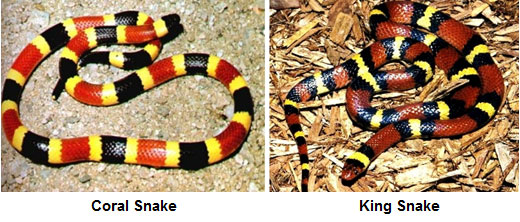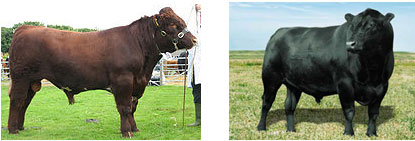
Ducks and geese are water birds. They live near ponds and lakes. The shape of a water bird’s feet helps it swim and walk on muddy ground. Which factor is the most important in determining the shape of a baby water bird’s feet?
A. The temperature of the pond water
Incorrect. The temperature of the pond water would have little effect on the shape of the bird’s feet.
B. The amount of rain fall in the area
Incorrect. The amount of rainfall in the area would have little effect on the shape of the bird’s feet.
C. The shape of the parent's feet
Correct! Adaptations are passed from generation to generation.
D. The type of food available in the area
Incorrect. The type of food in the area would have little effect on the shape of the bird’s feet.
The coral snakes have a color pattern of alternating black, yellow, and red stripes, and they are poisonous. The king snake has a similar striped color pattern to the coral snake, but they are not poisonous. The color pattern of the king snake is an example of —

A. camouflage
Incorrect. This is not an example of camouflage.
B. mimicry
Correct! This is an example of an adaptation known as mimicry.
C. parasitism
Incorrect. This is not an example of parasitism.
D. mutualism
Incorrect. This is not an example of mutualism.
Which of the following statements best describes natural selection?
A. The largest organisms in a species receive the only breeding opportunities.
Incorrect. The organisms with the favorable adaptations will survive, reproduce, and pass on the favorable adaptations to their offspring.
B. The organisms with the favorable adaptations will survive, reproduce, and pass on the favorable adaptations to their offspring.
Correct!
C. A species of organisms takes all of the resources in an environment and forces other species to migrate.
Incorrect. The organisms with the favorable adaptations will survive, reproduce, and pass on the favorable adaptations to their offspring.
D. The strongest organisms in a species receive the only breeding opportunities.
Incorrect. The organisms with the favorable adaptations will survive, reproduce, and pass on the favorable adaptations to their offspring.
White short-horned cattle and Black Angus cattle have been cross bred to produce offspring with superior beef quality. This process of choosing organisms for the most desirable traits for mating is known as —

A. cloning
Incorrect. Selective breeding is the process of choosing organisms for the most desirable traits for mating.
B. biodiversity
Incorrect. Selective breeding is the process of choosing organisms for the most desirable traits for mating.
C. genetic engineering
Incorrect. Selective breeding is the process of choosing organisms for the most desirable traits for mating.
D. selective breeding
Correct!
Due to rising temperatures in the ocean waters of Antarctica, there has been a decrease in the amount of sea ice causing a decline in the emperor and Adelie penguin populations since these penguins are depended on sea ice for feeding and breeding. However, there has been an increase in open-ocean feeding penguins, such as the chinstrap and the gentoo. Which statement best explains what is happening to the penguin population in the Antarctic?
A. The chinstrap and gentoo penguins were able to change their feeding habits and get food while the emperor and Adelie penguins were not.
Incorrect. Organisms do not change their behavior in order to adapt to a changing environment. The organisms with the advantageous trait survive and pass on the traits to their offspring.
B. The chinstrap and gentoo penguins have adaptions that allow them to feed in open waters that are now available due to the decreased amount of sea ice. These penguins will survive and pass on their traits to their offspring.
Correct!
C. The emperor and Adelie penguins will adapt and learn to feed in the open waters and their population will increase.
Incorrect. Organisms do not change their behavior in order to adapt to a changing environment. The organisms with the advantageous traits survive and pass on those traits to their offspring.
D. The increase in water temperature will cause immediate mutations in the penguin population, and the population size will increase.
Incorrect. Genetic mutations happen over time and are passed genetically from parent to offspring.